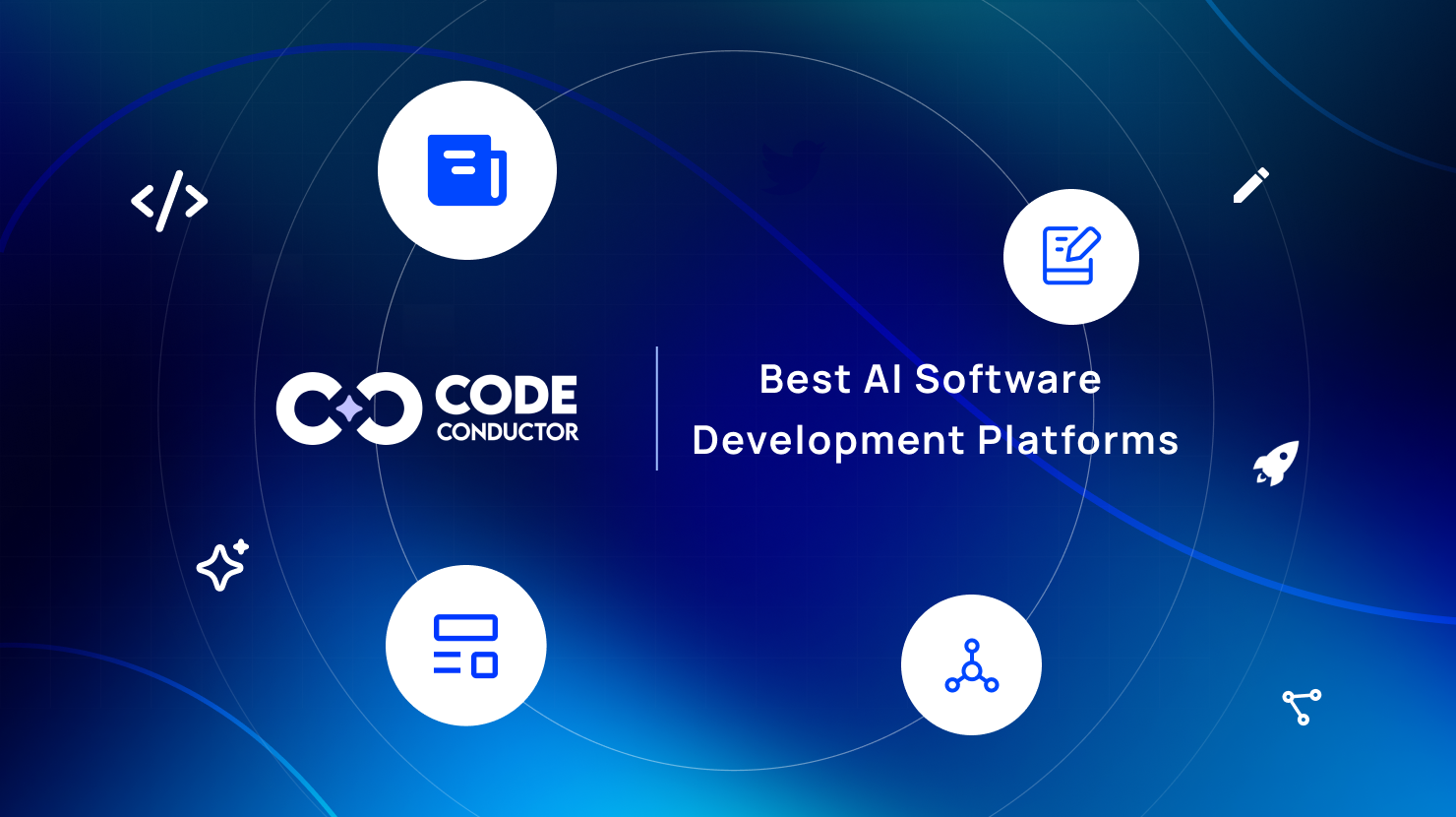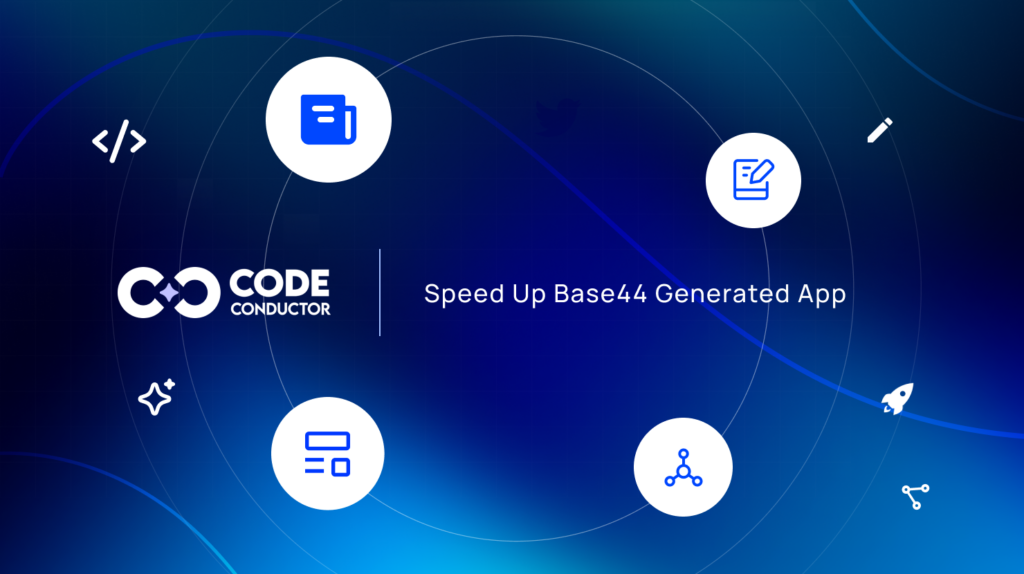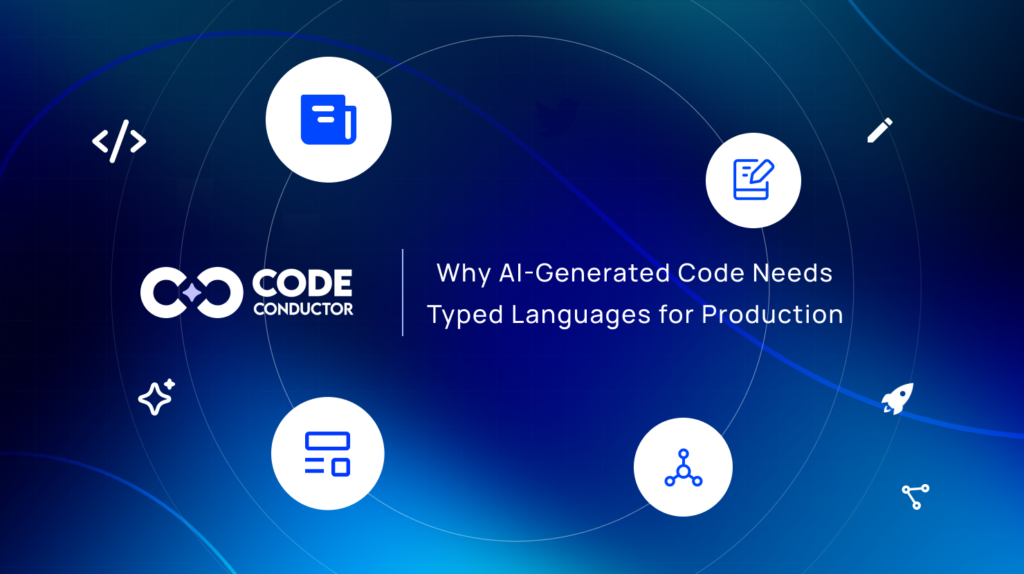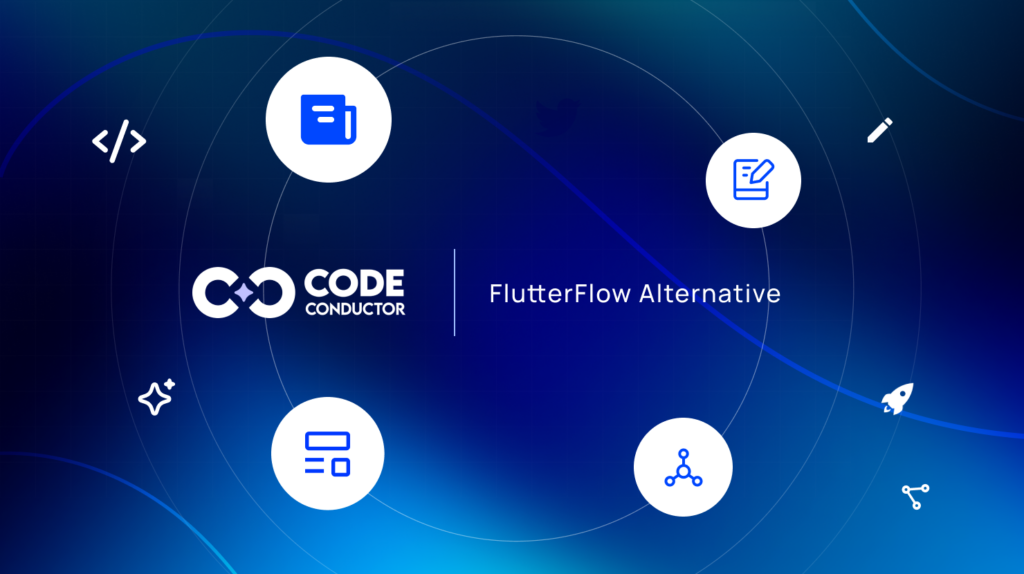Are you ready to find the best AI development platforms in 2026?
As developers, we’re always on the lookout for cutting-edge tools to elevate our projects. But with so many options, choosing the right AI platform can be a daunting task. 2026 is set to be a thrilling year for AI development platforms. And that’s why we need solutions that are reliable, scalable, and user-friendly, with seamless integration into our existing systems. And, of course, they need to be cost-effective.
The right AI platform can transform your workflow, automating tedious tasks, providing intelligent insights, and enabling the creation of powerful, innovative applications.
The growing number of platforms reflects just how central AI has become in everyday development. In fact, recent research shows that more than half of developers now rely on AI tools daily, saving hours each week that are often reinvested into learning and innovation. These insights, highlighted in the Dev Barometer Q3 2025, show why selecting the right platform is such an important decision.
So, what should we be looking for?
In this guide, we’ll walk you through the best AI development tools of 2026. We’ll delve into their key features, the benefits they offer, and how they can enhance your development process. Get ready to invest in the right technology and take your projects to the next level.
Let’s explore the top open source software development tools of 2026 and find the perfect fit for your needs!
Based on our comprehensive review, we’ve selected the Top AI development environments, each offering unique features and robust performance to empower software developers and engineers.
- CodeConductor
- TensorFlow
- PyTorch
- IBM Watson
- Microsoft Azure AI
- Amazon Web Services (AWS) AI
- Google Cloud AI
- H2O.ai
- DataRobot
- Keras
- Infosys Nia
In This Post
- What Exactly are AI-Powered Developer Tools?
- List of Top AI Software Development Tools in 2026
- 1. CodeConductor – World’s 1st AI Software Development Platform
- Features
- 2.TensorFlow – An end-to-end Platform for Machine Learning
- Features
- 3. PyTorch – Developer Community to Contribute & Learn
- Features
- 4. IBM Watson – Best AI Tools for Developers
- Features
- 5. Microsoft Azure AI – Multimodal & Generative AI Platform
- Features
- 6. Amazon Web Services (AWS) AI – Free Cloud Computing Services
- Features
- 7. Google Cloud AI – AI Platforms for Business
- Features
- 8. H2O.ai – Small Language Model for offline Applications
- Features
- 9. DataRobot AI Platform
- Features
- 10. Keras – Deep Learning for humans
- Features
- 11. Infosys Nia – AI Tools for Entrepreneurs
- Features
- AI for Software Development: Use Cases
- Advantages of AI & ML in Software Development
- Impact of Artificial Intelligence on Software Development
- People Also Ask Questions
- What are AI- Powered Machine Learning Tools?
- Why should I use an AI development platform?
- How does CodeConductor differ from others?
- How do I choose the right AI platform for my needs?
- Can non-developers use these AI platforms?
- How much do these AI development platforms cost?
- What industries can benefit from using AI development platforms?
- Where can I find support and resources for these platforms?
- References
What Exactly are AI-Powered Developer Tools?
Think about having a toolbox full of all the tools you need to build intelligent applications that could make your coding process faster, more efficient, and more error-free. AI-empowered software assistants provide developers with a suite of tools, libraries, frameworks, and services designed specifically to create AI-powered applications. These platforms make it easier to integrate machine learning, natural language processing, computer vision, and other AI capabilities into your projects. AI tools for developers to help boost your productivity are cutting-edge applications designed to automate repetitive tasks, enhance code quality, and provide intelligent suggestions, significantly improving your workflow efficiency and allowing more time for creative problem-solving. So, why should you care about these platforms? Here’s why:
- These platforms simplify complex AI development processes with user-friendly interfaces, pre-built models, and drag-and-drop functionalities.
- They offer seamless integration with other tools and services, making it easy to connect and extend your capabilities.
- AI platforms provide a robust infrastructure to handle increasing data loads, more users, and complex computations as your projects grow.
- Established AI platforms come with access to tutorials, forums, and customer support, providing invaluable assistance when tackling new challenges.
- They offer cost-effective solutions that help you deploy projects faster and more efficiently, with flexible pricing models to fit different budgets.
Hence, artificial intelligence-based tools in the software development process provide the foundation and resources you need to develop smart, reliable, and innovative applications or products for your business.
Key Features to Look for in AI-empowered Software Assistants
When it comes to choosing the perfect AI software frameworks, it’s essential to know what features to look for. The right features can make a significant difference in your development process, helping you create smarter, more efficient applications.
Here are some key features to keep an eye on:
1. Ease of Use – A user-friendly interface and intuitive design can drastically reduce the learning curve, allowing you to focus more on innovation rather than navigating complex tools.
- What to Look For: Platforms that offer drag-and-drop interfaces, comprehensive documentation, and a supportive community.
2. Integration Capabilities – Seamless integration with existing tools and systems ensures that you can easily incorporate AI capabilities into your current workflow without major disruptions.
- What to Look For: APIs, plugins, and compatibility with popular development environments and software.
3. Scalability – As your projects grow, your platform should be able to handle increased workloads without compromising performance.
- What to Look For: Cloud support, flexible architecture, and the ability to manage large datasets efficiently.
4. Support and Community – Access to reliable support and an active community can provide invaluable assistance, from troubleshooting issues to sharing best practices.
- What to Look For: Comprehensive support options, active forums, and a wealth of user-generated content such as tutorials and guides.
5. Cost and Licensing – Understanding the cost structure and licensing options is crucial for budgeting and ensuring the long-term sustainability of your projects.
- What to Look For: Transparent pricing models, flexible subscription plans, and clear licensing terms.
6. Security – Protecting your data and ensuring compliance with security standards is paramount, especially when dealing with sensitive information.
- What to Look For: Robust security features, encryption, and compliance with industry standards and regulations.
7. Performance and Speed – High performance and fast processing speeds are essential for handling complex AI algorithms and large datasets efficiently.
- What to Look For: Optimized processing capabilities, low latency, and high throughput.
8. Customization and Flexibility – Every project is unique, so having the ability to customize the platform to fit your specific needs can be a significant advantage.
- What to Look For: Configurable settings, modular components, and support for various AI models and frameworks.
9. Future-Proofing – Technology is constantly evolving, and your platform should be able to adapt to new advancements and trends in AI.
- What to Look For: Regular updates, active development, and a roadmap for future enhancements.
This ensures that you select an AI model deployment that not only meets your current needs but also supports your growth and innovation well into the future.
List of Top AI Software Development Tools in 2026
The following list will help you identify the best conversational AI development platforms to enhance your development projects and stay ahead in the rapidly evolving tech marketplace. Let’s check them out!
| Platform | Known For | Price | Ratings |
|---|---|---|---|
| CodeConductor | Best for AI Software Development Overall | Paid, Get a free demo | ★★★★★ 4.9 |
| TensorFlow | Best AI Development Software for Machine Learning | Free (Open Source), Paid options available | ★★★★☆ 4.6 |
| PyTorch | Best AI Development Software for Research and Prototyping | Free (Open Source), Paid options available | ★★★★☆ 4.6 |
| IBM Watson Studio | Best AI Development Software For Q&A | Paid | ★★★★☆ 4.3 |
| Microsoft Azure AI | Best AI Development Software For Enterprise Customers | Starting from $140/month | ★★★★☆ 4.6 |
| AWS AI | Best AI Software Development Tool for Scalability and Flexibility | Pay-as-you-go pricing model | ★★★★☆ 4.4 |
| Google Cloud AI | Best AI Development Software Overall | Paid | ★★★★☆ 4.6 |
| H2O.ai | Best Open Source AI Development Software | Free (Open Source) options available | ★★★★☆ 3.1 |
| DataRobot | Best AI Development Software for Automated Machine Learning | Paid | ★★★★☆ 4.6 |
| Keras | Best AI Development Software for Easy and Fast Experimentation | Free (Open Source) | ★★★★☆ 4.6 |
| Infosys Nia | Best AI Development Software for Business Process Automation | No Pricing Availability | ★★★☆☆ 4.4 |
Here is a detailed overview of the list of top software development cloud platforms:
1. CodeConductor – World’s 1st AI Software Development Platform
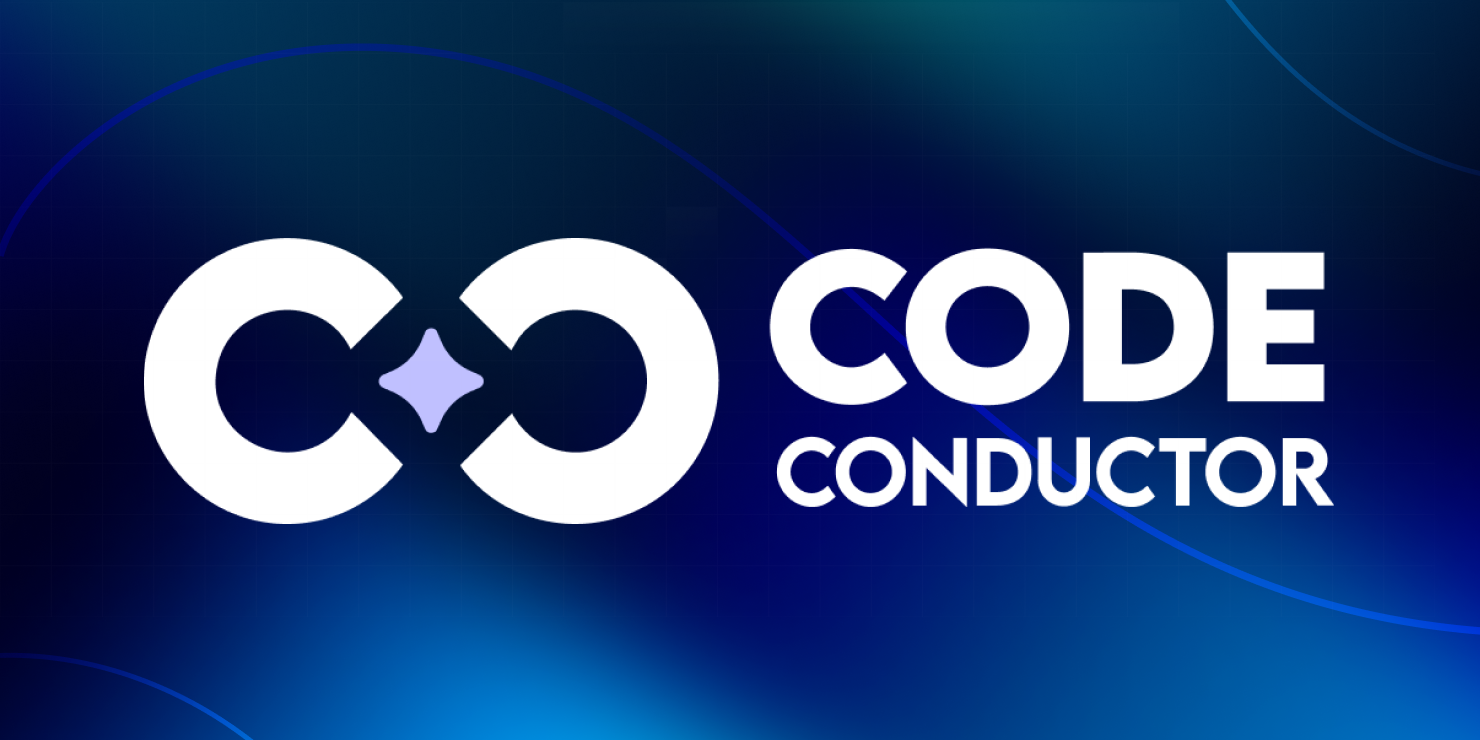
CodeConductor is an AI-powered software development platform known for its seamless integration of AI. This platform enables users to automate decision-making processes and streamline product or app development. With an intuitive interface and powerful AI-driven tools, CodeConductor empowers developers, app founders, product managers, and other industry experts to build sophisticated applications effortlessly.
Features
- Scalability: Easily scalable to handle projects of any size.
- Integration: Seamless integration with popular development tools and frameworks.
- User Interface: Intuitive and user-friendly interface for easy navigation.
- Support: Comprehensive support and extensive documentation.
- Automation: Advanced automation capabilities for streamlined workflows.
Why We Picked It: CodeConductor stands out for its user-friendly interface and advanced automation features, making it accessible to both beginners and experts. Its ability to integrate seamlessly with other development tools enhances its functionality.
Why Is It Best: CodeConductor is ideal for those looking to develop sophisticated applications with minimal effort. Its powerful AI-driven tools and intuitive design make the development process efficient and straightforward.
Pricing: CodeConductor offers a flexible pricing model with different tiers based on the features and level of support required. You can get a free demo.
2.TensorFlow – An end-to-end Platform for Machine Learning

TensorFlow, developed by Google, is a leading Predictive Analytics tool renowned for its flexibility and comprehensive ecosystem. It supports a wide range of machine learning and deep learning tasks, making it a favorite among data scientists and AI researchers.
Features
- Scalability: Capable of handling large-scale machine learning models.
- Flexibility: Supports various machine learning algorithms and models.
- Community Support: Extensive community support and resources.
- Integration: Integrates with various tools and platforms, including Google Cloud.
- Performance: Optimized for high-performance computation.
Why We Picked It: TensorFlow’s robust features and extensive support community make it a go-to choice for complex AI projects. Its integration with Google Cloud enhances its scalability and performance.
Why Is It Best: TensorFlow is best for developers and researchers working on large-scale machine learning models. Its flexibility and comprehensive ecosystem provide the tools needed for advanced AI development.
Pricing: TensorFlow is open-source and free to use. Costs may arise from using additional Google Cloud services, which follow a pay-as-you-go pricing model.
3. PyTorch – Developer Community to Contribute & Learn

PyTorch, developed by Facebook’s AI Research lab, is another popular AI development platform favored for its dynamic computational graph and ease of use. It is widely used for both research and production purposes in machine learning.
Features
- Dynamic Graphs: Supports dynamic computational graphs for flexible development.
- User-Friendly: Intuitive and easy-to-use interface.
- Community Support: Strong community support and extensive documentation.
- Performance: Optimized for performance in research and production settings.
- Integration: Integrates well with other development tools and platforms.
Why We Picked It: PyTorch is selected for its simplicity and flexibility, making it ideal for rapid prototyping. Its dynamic computational graph support is particularly beneficial for researchers.
Why Is It Best: PyTorch is best for developers and researchers who need a flexible and easy-to-use platform for machine learning experiments. Its strong community support further enhances its usability.
Pricing: PyTorch is open-source and free to use, with no associated costs unless integrated with paid third-party services.
4. IBM Watson – Best AI Tools for Developers
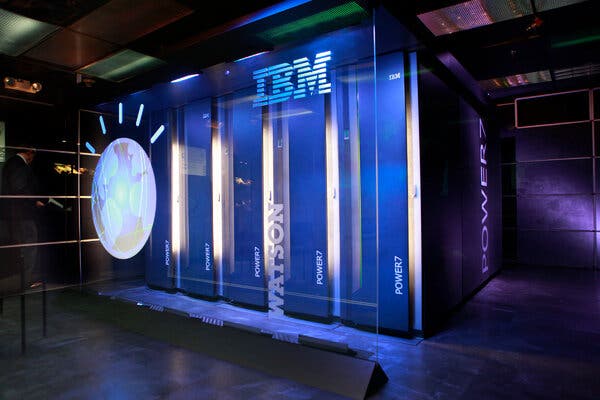
IBM Watson Studio is a powerful AI platform that offers a range of tools and services for developing AI applications. Known for its natural language processing capabilities, Watson is used across various industries to enhance business operations and customer experiences.
Features
- NLP Capabilities: Advanced natural language processing tools.
- Machine Learning: Comprehensive machine learning tools and frameworks.
- Integration: Seamless integration with other IBM services and third-party tools.
- Scalability: Highly scalable for various business needs.
- Support: Robust support and extensive resources.
Why We Picked It: IBM Watson’s advanced NLP capabilities and a broad range of tools make it a strong choice for businesses looking to implement AI across various operations.
Why Is It Best: IBM Watson is best for enterprises needing advanced AI capabilities, particularly in natural language processing. Its extensive toolset and robust support make it a reliable choice for business-critical applications.
Pricing: IBM Watson offers tiered pricing based on usage and specific services. It starts from $140/month and includes 1,000 MAUs.
5. Microsoft Azure AI – Multimodal & Generative AI Platform
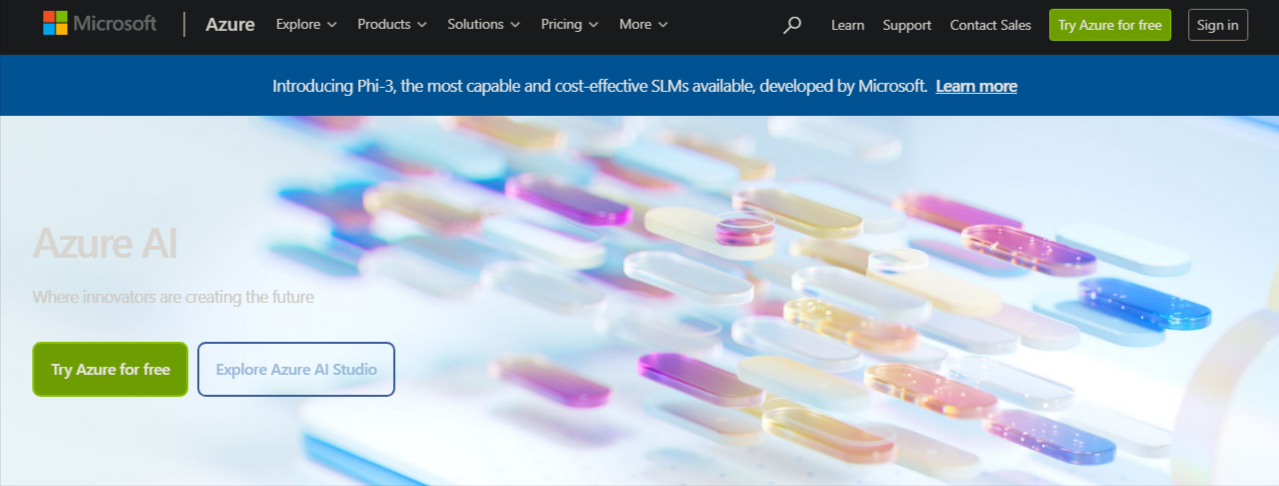
Microsoft Azure AI is a suite of AI services and tools provided by Microsoft. It offers a broad range of capabilities, including machine learning, cognitive services, and bot services, making it a versatile platform for AI development.
Features
- Machine Learning: Extensive machine learning tools and frameworks.
- Cognitive Services: Advanced cognitive services for AI applications.
- Integration: Seamless integration with other Microsoft products and services.
- Scalability: Scalable solutions to meet various business needs.
- Support: Comprehensive support and extensive documentation.
Why We Picked It: Microsoft Azure AI’s extensive range of services and seamless integration with other Microsoft products make it a versatile and powerful platform.
Why Is It Best: Azure AI is best for organizations already utilizing Microsoft products, as its integration capabilities enhance the overall functionality and ease of use within existing systems.
Pricing: Microsoft Azure AI is free to use but also follows a pay-as-you-go pricing model, with costs based on specific services and usage levels.
6. Amazon Web Services (AWS) AI – Free Cloud Computing Services
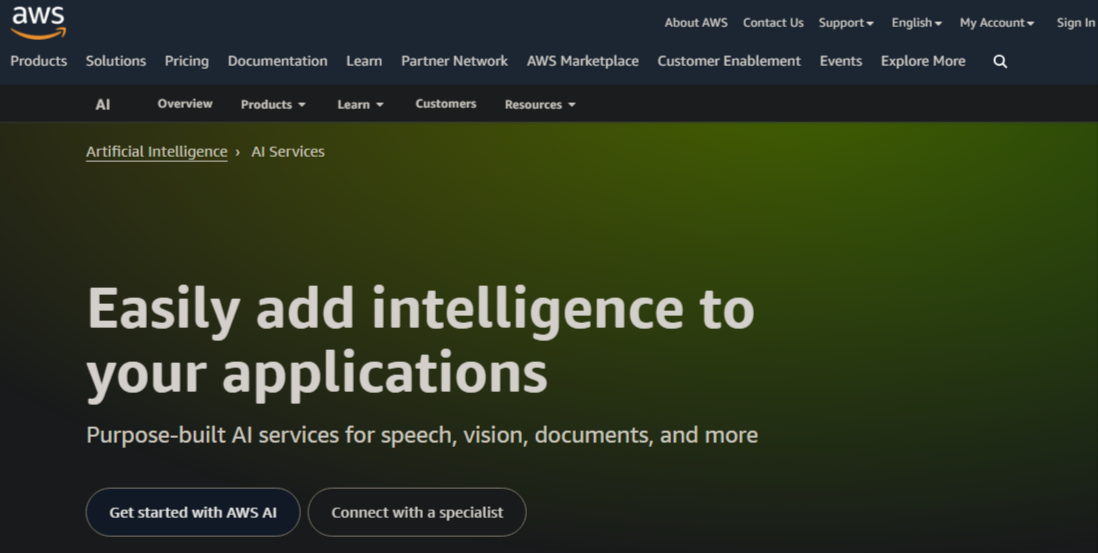
Amazon Web Services (AWS) AI offers a comprehensive set of AI and machine learning services. Known for its scalability and flexibility, AWS AI supports a wide range of AI applications, from natural language processing to computer vision.
Features
- Scalability: Highly scalable to handle large-scale AI applications.
- Flexibility: Flexible tools and frameworks for various AI tasks.
- Integration: Seamless integration with other AWS services
- Machine Learning: Comprehensive machine learning services.
- Support: Robust support and extensive resources.
Why We Picked It: AWS AI is selected for its unparalleled scalability and extensive suite of AI services, making it suitable for projects of any size.
Why Is It Best: AWS AI is best for developers needing a highly scalable and flexible platform. Its wide range of services supports various AI tasks, from simple models to complex machine-learning applications.
Pricing: As part of the AWS Free Tier, you can start using Amazon A2I for free, with up to 500 human reviews included in the first year (42 per month). Costs for AWS Marketplace vendors or Amazon Mechanical Turk are not included.
7. Google Cloud AI – AI Platforms for Business

Google Cloud AI provides a suite of AI tools and services designed to streamline the development and deployment of AI applications. It offers powerful machine-learning capabilities and integrates seamlessly with other Google Cloud services.
Features
- Machine Learning: Advanced machine learning tools and frameworks.
- Integration: Seamless integration with other Google Cloud services.
- Scalability: Scalable solutions for various AI projects.
- Performance: Optimized for high performance and efficiency.
- Support: Comprehensive support and extensive documentation.
Why We Picked It: Google Cloud AI is chosen for its advanced machine learning tools and seamless integration with Google’s robust cloud infrastructure.
Why Is It Best: Google Cloud AI is best for organizations looking to leverage Google’s advanced AI and machine learning capabilities, particularly for large-scale data processing and model training.
Pricing: Google Cloud AI follows a pay-as-you-go pricing model.
8. H2O.ai – Small Language Model for offline Applications

H2O.ai is an open-source AI platform known for its machine learning and data analysis capabilities. It offers tools for building predictive models and automating machine learning workflows.
Features
- Open Source: Open-source platform with extensive customization options.
- Machine Learning: Comprehensive machine learning tools and frameworks.
- Integration: Integrates well with various data sources and tools.
- User-Friendly: Intuitive interface and ease of use.
- Support: Strong community support and resources.
Why We Picked It: H2O.ai is selected for its powerful machine-learning capabilities and open-source nature, allowing for extensive customization.
Why Is It Best: H2O.ai is best for developers looking for a flexible, open-source solution for machine learning and data analysis, with strong community support.
Pricing: H2O.ai is open-source and free to use, with additional enterprise features available at a cost.
9. DataRobot AI Platform
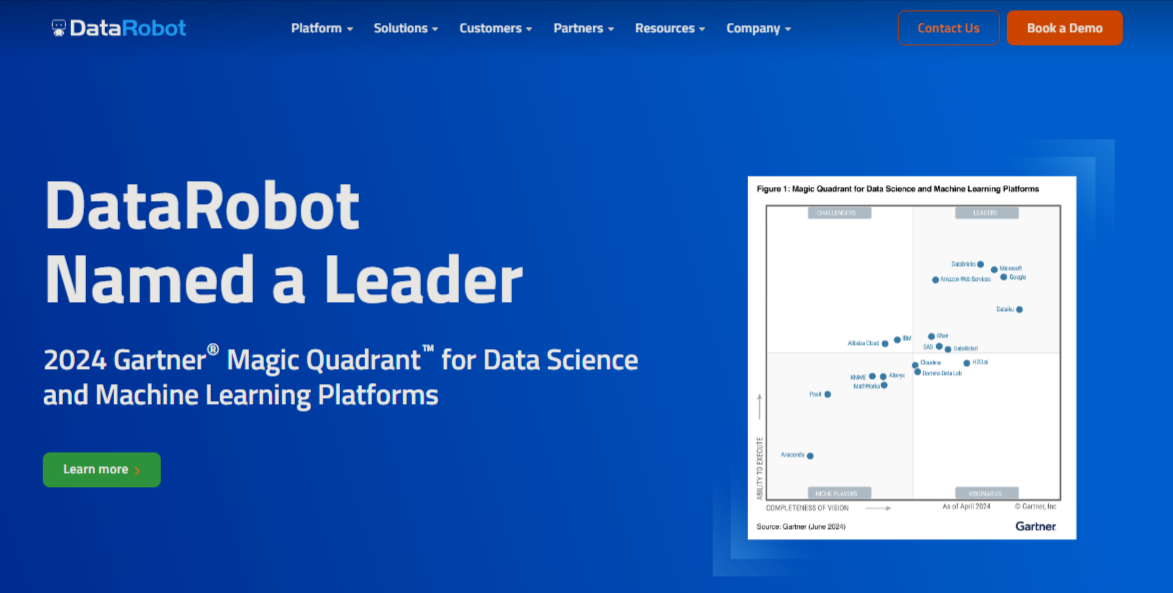
DataRobot is an automated machine-learning platform designed to simplify the process of building and deploying predictive models. It offers a user-friendly interface and advanced automation features.
Features
- Automation: Advanced automation capabilities for building and deploying models.
- User-Friendly: Intuitive and user-friendly interface.
- Integration: Seamless integration with various data sources and tools.
- Machine Learning: Comprehensive machine learning tools and frameworks.
- Support: Extensive support and resources.
Why We Picked It: DataRobot’s automation capabilities and user-friendly interface make it an excellent choice for reducing the time and effort required for model development.
Why Is It Best: DataRobot is best for organizations looking to streamline their machine learning workflow with advanced automation, making it accessible to users with varying levels of expertise.
Pricing: The DataRobot AI Platform is available through an annual subscription model. Organizations have the flexibility to tailor their solution to align with specific business objectives.
10. Keras – Deep Learning for humans
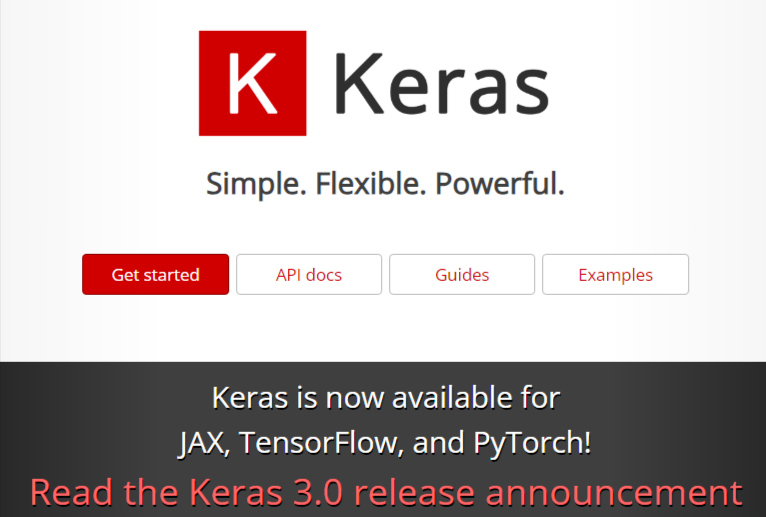
Keras is an open-source neural network library written in Python. It is capable of running on top of TensorFlow, Microsoft Cognitive Toolkit, R, Theano, or PlaidML. Keras is designed to enable fast experimentation with deep neural networks and is known for its user-friendly, modular, and extensible design.
Features
- User-Friendly: Simple and easy-to-use interface.
- Modularity: Modular structure allows easy extension.
- Integration: Works seamlessly with TensorFlow and other backends.
- Flexibility: Supports both convolutional networks and recurrent networks.
- Performance: Optimized for high performance in deep learning tasks
Why We Picked It: Keras is chosen for its simplicity and ease of use, making it accessible for both beginners and advanced users in deep learning.
Why Is It Best: Keras is best for developers and researchers looking for a user-friendly and flexible deep-learning framework, with strong integration capabilities.
Pricing: Keras is open-source and free to use, with no associated costs unless integrated with paid third-party services.
11. Infosys Nia – AI Tools for Entrepreneurs

Infosys Nia is an AI platform designed for business process automation and data analysis. It offers tools for predictive analytics, machine learning, and natural language processing.
Features
- Automation: Advanced automation capabilities for business processes.
- Analytics: Powerful tools for predictive analytics and data analysis.
- Integration: Seamless integration with various enterprise systems.
- Machine Learning: Comprehensive machine learning tools and frameworks.
- Support: Robust support and resources.
Why We Picked It: Infosys Nia was selected for its comprehensive suite of AI tools and its ability to automate complex business processes.
Why Is It Best: Infosys Nia is best for enterprises looking to enhance efficiency through business process automation and advanced analytics.
Pricing: Infosys Nia not yet has provided pricing information.
AI for Software Development: Use Cases
Artificial Intelligence is no longer a futuristic concept; it’s a present-day reality transforming industries across the globe. Here, we explore some compelling use cases of AI Development Environments, showcasing how different sectors are leveraging AI to drive innovation, efficiency, and growth.
1. Healthcare: Enhancing Diagnostics and Patient Care
- Example: IBM Watson Health
- Overview: IBM Watson Health uses AI to analyze vast amounts of medical data, assisting doctors in diagnosing diseases and suggesting treatment plans.
- Impact: With AI-powered diagnostic tools, healthcare professionals can make more accurate diagnoses, reduce the time needed for analysis, and offer personalized treatment plans to patients. This results in better patient outcomes and more efficient healthcare delivery.
Key Points:
- Faster and more accurate disease detection
- Personalized treatment recommendations
- Improved patient care and management
2. Finance: Automating Fraud Detection
- Example: PayPal
- Overview: PayPal utilizes AI to detect fraudulent transactions in real-time. By analyzing patterns and anomalies in transaction data, AI algorithms can identify potential fraud before it occurs.
- Impact: This proactive approach significantly reduces the risk of fraud, protecting both the company and its customers. Additionally, AI-driven fraud detection systems are more efficient and cost-effective compared to traditional methods.
Key Points:
- Real-time fraud detection
- Enhanced security for transactions
- Cost-effective fraud management
3. Retail: Optimizing Supply Chain Management
- Example: Amazon
- Overview: Amazon employs AI to streamline its supply chain operations. From inventory management to demand forecasting, AI algorithms help predict product demand, optimize stock levels, and enhance delivery logistics.
- Impact: By using AI, Amazon ensures that products are available when customers need them, reducing the chances of stockouts and overstock situations. This leads to higher customer satisfaction and more efficient supply chain operations.
Key Points:
- Improved inventory management
- Accurate demand forecasting
- Enhanced delivery logistics
4. Manufacturing: Predictive Maintenance
- Example: General Electric (GE)
- Overview: GE uses AI to predict equipment failures before they occur. By analyzing data from sensors embedded in machinery, AI can identify patterns indicating potential malfunctions.
- Impact: Predictive maintenance minimizes downtime, reduces maintenance costs, and extends the lifespan of equipment. This leads to significant cost savings and increased operational efficiency.
Key Points:
- Reduced equipment downtime
- Lower maintenance costs
- Extended equipment lifespan
5. Marketing: Personalizing Customer Experiences
- Example: Netflix
- Overview: Netflix uses AI to personalize content recommendations for its users. By analyzing viewing habits and preferences, AI algorithms suggest movies and TV shows that are likely to interest each user.
- Impact: Personalized recommendations enhance user engagement and satisfaction, leading to increased subscription retention rates. This approach helps Netflix stay competitive in the streaming market.
Key Points:
- Personalized content recommendations
- Increased user engagement
- Higher subscription retention
Advantages of AI & ML in Software Development
Integrating software development applications ensures scalability and provides a competitive edge, enabling faster and more efficient delivery of innovative products. Let’s make your development process and propel your projects to new heights with AI integration.
1. Efficiency and Automation
Integrating AI Software Development Solutions significantly enhances efficiency. These platforms automate repetitive tasks such as code generation, testing, and debugging. Automation not only speeds up the development process but also allows developers to focus on more complex and creative aspects of their projects.
Consider a scenario where routine bug fixes and code optimizations are handled seamlessly by AI, freeing up valuable time for innovation and improvement.
2. Increase Accuracy and Error Reduction
AI-driven development platforms are adept at identifying and correcting errors in code. They utilize machine learning algorithms to predict potential issues and offer solutions before problems escalate. This proactive approach reduces the likelihood of bugs making it to the final product, ensuring a higher-quality output.
In addition to minimizing human error, using AI leads to more robust and reliable applications.
3. Enhance Innovation and Creativity
AI platforms empower developers to experiment with new ideas and approaches. With AI handling routine tasks, developers have more time to explore innovative solutions and push the boundaries of what’s possible. AI can also provide insights and recommendations based on vast amounts of data, inspiring new features and functionalities that might not have been considered otherwise.
This fosters a culture of creativity and continuous improvement within development teams.
4. Scalability and Performance Optimization
Automated Machine Learning (AutoML) tools are designed to scale effortlessly, accommodating projects of varying sizes and complexities. They provide tools and frameworks that help manage resources efficiently, ensuring optimal performance even as the project grows.
AI can also analyze real-time performance metrics, identifying bottlenecks and suggesting improvements to enhance the application’s speed and responsiveness.
5. Competitive Advantage
Adopting AI in software development gives organizations a competitive edge. Companies that leverage AI tools are better positioned to deliver innovative products faster and more efficiently. The ability to quickly adapt to market changes and customer demands is crucial in today’s fast-paced tech landscape.
Through AI, businesses can remain competitive and meet the changing needs of their users with agility.
Impact of Artificial Intelligence on Software Development
So, Alex, my final thoughts on this blog is adding AI to your software development workflow can significantly improve your productivity, accuracy, and innovation.
The scalability and performance optimization capabilities of these platforms ensure that your projects can grow seamlessly, maintaining high performance and responsiveness. The competitive advantage gained through the adoption of AI-driven development cannot be overstated. Adaptability, speed, and efficiency are critical in an age where organizations strive to keep up with market demands and customer expectations through AI tools.
So, if you are ready to experience these benefits firsthand, CodeConductor is a leading AI software development platform designed to streamline your development process. With CodeConductor, you can automate mundane tasks, optimize performance, and gain actionable insights that will take your projects to the next level.
Don’t just take my word for it—see the impact of CodeConductor for yourself. I invite you to book a free demo and discover how this platform can change your development workflow. Book your free demo of CodeConductor today and step into the future of AI-powered software development!
People Also Ask Questions
What are AI- Powered Machine Learning Tools?
AI- Powered machine learning tools are specialized tools and frameworks that assist developers in building, training, and deploying AI models and applications. The best Artificial intelligence softwares are:
- CodeConductor
- TensorFlow
- PyTorch
- IBM Watson
- Microsoft Azure AI
- Amazon Web Services (AWS) AI
- Google Cloud AI
Why should I use an AI development platform?
Using an AI development platform simplifies the process of developing AI applications by providing pre-built tools and frameworks. These platforms offer scalability, integration with existing tools, advanced machine learning capabilities, and support, making it easier for developers to create sophisticated AI solutions efficiently.
How does CodeConductor differ from others?
CodeConductor distinguishes itself with its seamless integration of AI and its focus on automation, making it a standout choice among AI development platforms. Unlike others, CodeConductor’s user-friendly interface and advanced AI-driven tools allow users to streamline the development of applications with minimal effort. Its robust support and comprehensive documentation further enhance the user experience, making it accessible even to those with limited coding skills.
How do I choose the right AI platform for my needs?
To choose the right AI platform, consider factors such as:
- Ease of use: How user-friendly is the platform?
- Integration: Can it integrate with your existing tools and systems?
- Scalability: Can it handle the size and complexity of your projects?
- Support and Community: Is there sufficient documentation and community support?
- Cost: Does the pricing fit your budget and offer good value for the features provided?
Can non-developers use these AI platforms?
Platforms like CodeConductor and DataRobot are designed to be user-friendly, with intuitive interfaces and automation features that simplify the development process. However, to truly get into these tools, non-developers will need support and training. With the right guidance, beginners can become proficient and impressively tech-savvy.
How much do these AI development platforms cost?
The cost of AI development platforms varies:
- Open-source platforms like TensorFlow, PyTorch, and Keras are free to use.
- Subscription-based platforms like DataRobot and IBM Watson offer tiered pricing based on usage and features.
- Cloud-based platforms like AWS AI and Google Cloud AI use a pay-as-you-go pricing model.
For specific pricing details, it is best to visit the official websites of each platform.
What industries can benefit from using AI development platforms?
AI development platforms are beneficial across various industries, including:
- Healthcare: For predictive analytics and personalized medicine.
- Finance: For fraud detection and algorithmic trading.
- Retail: For customer personalization and demand forecasting.
- Manufacturing: For predictive maintenance and quality control.
- Logistics: For route optimization and supply chain management.
Where can I find support and resources for these platforms?
Most AI development platforms, like CodeConductor, AWS AI, DataRobot, and others, offer extensive documentation, tutorials, and community forums on their official websites. Additionally, platforms like TensorFlow and PyTorch have large user communities that provide support through forums, GitHub repositories, and online courses.
References
- AutoML: A Survey of the State-of-the-Art
- Artificial Intelligence Platforms – A New Research Agenda
- Algorithms, data, and platforms: the diverse challenges of governing AI
- The ML Test Score: A Rubric for ML Production Readiness and Technical Debt Reduction

Founder CodeConductor

